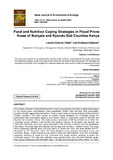| dc.contributor.author | Odida, Lynette Ochuma | |
| dc.contributor.author | Nabiswa, Ferdinand | |
| dc.date.accessioned | 2021-12-15T04:43:26Z | |
| dc.date.available | 2021-12-15T04:43:26Z | |
| dc.date.issued | 2020-10-26 | |
| dc.identifier.uri | https://doi.org/10.9734/ajee/2020/v13i430189 | |
| dc.identifier.uri | https://www.journalajee.com/index.php/AJEE/article/view/30189 | |
| dc.identifier.uri | http://ir-library.mmust.ac.ke:8080/xmlui/handle/123456789/1836 | |
| dc.description.abstract | The nutrition situation in flood affected areas in Kenya is precarious and likely to deteriorate sharply in the coming years. Humanitarian crises exacerbate nutrition risks and poor food consumption practices thereby aggravating malnutrition. There is lack of data on the pre and post floods food and nutrition situation. This study sought to assess Coping strategies by vulnerable groups for sustainable food consumption patterns and nutrition status in flood prone areas of Bunyala and Nyando Sub Counties, Kenya. The study sample comprised of 208 households out of which the vulnerable groups (children 6-59 months and lactating mothers 15-49 years) was derived, key informants interviews and focus group discussions and informed consents from the participants were taken. The study sites were Nyando and Bunyala Sub counties, in western Kenya. The areas were purposively selected given the long history of floods over time, the study started from 4th November to 15th December, 2018. The study adopted a cross sectional descriptive survey and evaluation design. Cluster sampling was used to select the administrative units and households, purposive sampling to select the key informants and simple random sampling to select the vulnerable groups. The data was collected using questionnaires, key informant interview guide, focus group discussions and secondary data. The data was analyzed by SPSS version 16, Nutri-survey and ENA soft wares. Chi square statistical test was used to determine the relationship between the food consumption patterns and nutritional status of the vulnerable groups. The results were then presented using tables and graphs. The main findings were that most households continued to stay in flood prone areas despite early warnings and food aid was hardly available. The coping strategies were limited with majority adjusting the frequency of food intake and type of food eaten. The study concluded that the coping strategies were varied and uncoordinated and therefore not sustainable. Thus, there is need to build community resilience through expanding multi-agency social protection programs in flood prone areas to cushion the vulnerable groups against food and nutrition insecurity. | en_US |
| dc.language.iso | en | en_US |
| dc.publisher | Asian Journal of Environment & Ecology | en_US |
| dc.subject | Food, Nutrition, Coping, Strategies, Flood Prone, Areas, Bunyala, Nyando | en_US |
| dc.title | Food and Nutrition Coping Strategies in Flood Prone Areas of Bunyala and Nyando Sub Counties Kenya | en_US |
| dc.type | Article | en_US |

